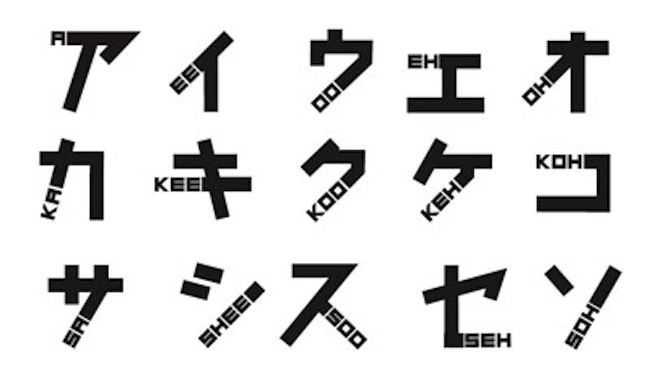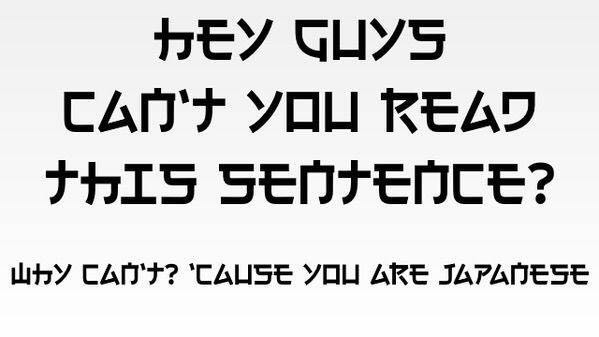Phonetikana
« previous post | next post »
On the DramaFever website, Brendan Fitzgibbons has an interesting article that shows how "New font lets anyone learn Japanese" (10/17/14):
Although the article dates to a year ago, it turns out to be timely, at least for me, since just within the last two days I found out about an attempt to write English in a katakana-like script:
This latter font, called Electroharmonix, was actually created more than fourteen years ago and was circulated more than a year ago, but is making the rounds again now, as is Phonetikana.
I personally prefer Phonetikana because it enables anyone who is interested in beginning to use genuine katakana immediately and, in so doing, to learn them for potential application in Japanese language learning. The key to the success of Phonetikana is that it comes with ingeniously built-in phonetic annotations.
The versatility of this katakana font is demonstrated in the article by Fitzgibbons, where it is cleverly employed in a number of pleasing graphic designs that include English words as well as actual Japanese words.
I might add that the phonetic annotations are spelled in such a way as to be highly self-evident and effective for pronouncing the kana in a manner that sounds quite Japanese.


shubert said,
October 22, 2015 @ 7:35 am
A smarter way than one in another new book, (published in 2014), which tries to draw image around each Hanzi.
phspaelti said,
October 22, 2015 @ 8:54 am
ee, oo, eh, oh, ugh!
J. W. Brewer said,
October 22, 2015 @ 9:26 am
not sure why a/ka/sa aren't expanded to ah/kah/sah to have a consistent approach. If you trust Anglophones to come up with the right vowel for those, you ought to have trusted them to guess right for o/ko/so without expansion.
L said,
October 22, 2015 @ 9:33 am
Okay, this seems pretty cool. But I think it might be a better educational tool if it reflected standard romanization of Japanese. For example, in the systems of romanization that use "koh" and "soh," they would refer to "コー" and "ソー," respectively, not to "コ" and "ソ." And "kee" would refer to "ケー," I think. Those are just a few examples–actually only three of the katakana shown in the image above reflect the romanization of those kana.
It seems to me like people might use this in conjunction with other materials, and the inconsistencies could cause confusion. Also, the Japanese themselves use romanized Japanese sometimes, so learning standard romanization systems is actually part of learning Japanese, not just an aid to it.
JS said,
October 22, 2015 @ 9:52 am
Crazy… I devised a broadly similar but vastly superior (:P) system for remembering kana back when I was learning — now, how do I monetize it?
Guy said,
October 22, 2015 @ 10:55 am
I'm not a pedagogical expert, but I think this kind of crutch would only prolong the time it takes to learn katakana. Relying on the English lettering will distract the person's attention away from the kana and places no burden on the learner to develop an association between the symbol and the sound.
Eidolon said,
October 22, 2015 @ 12:22 pm
@Guy perhaps, but on the other hand, it is an excellent example of technology facilitating language translation, in this case phonetic language translation, as being a font, you could automatically convert any katakana into this using a mobile device with a camera.
cacarr said,
October 22, 2015 @ 12:44 pm
Looks like a great way to learn a romaji system no one uses.
Guy said,
October 22, 2015 @ 1:15 pm
@Eidolon Not to be all negative about everything, but what Japanese is written entirely in katakana? And how would it be helpful in translation to transcribe katakana into a highly idiosyncratic Latin letter phonetic representation based on English orthography? One that would apparently use letter sequences like "eheh" and "oooo" to represent individual long vowels sounds?
Nicholas Feinberg said,
October 22, 2015 @ 5:52 pm
Tracing it back, it looks like the "new font" wasn't even new in 2014 – the original dates back to 2009. ( http://johnsonbanks.co.uk/thoughtfortheweek/phonetikana/ – the poor images suffered some terrible jpeg compression in the 6-year-long game of telephone, they're much crisper on the original site.)
Anyway, it's cool, flawed or not.
Joseph said,
October 23, 2015 @ 6:24 am
I was suprised that my Japanese girlfriend, who is a strong reader of English, was unable to read the katakana looking script. This would be useful if ever in the situation of sharing some written message with only non-Japanese English speakers.
Victor Mair said,
October 23, 2015 @ 7:52 am
Here is another instance of how Roman letters and katakana can interact.
One of the most widespread Roman letter acronyms ("initialisms" for the nitpickers) is OL, meaning "office ladies". In Japanese, OL is pronounced as ōeru, which is written in katakana as オーエル.
https://en.wikipedia.org/wiki/Office_lady
https://ja.wikipedia.org/wiki/OL
Usually Dainichi said,
October 23, 2015 @ 10:44 am
It took me a while to realize that the first line of the katakana-like script is "hey guys". I read it as "カモン guys", "kamon guys" i.e. "come on guys", although the "y" looks more like a ソ than a ン.
"'cause you are Japanese", I guess?